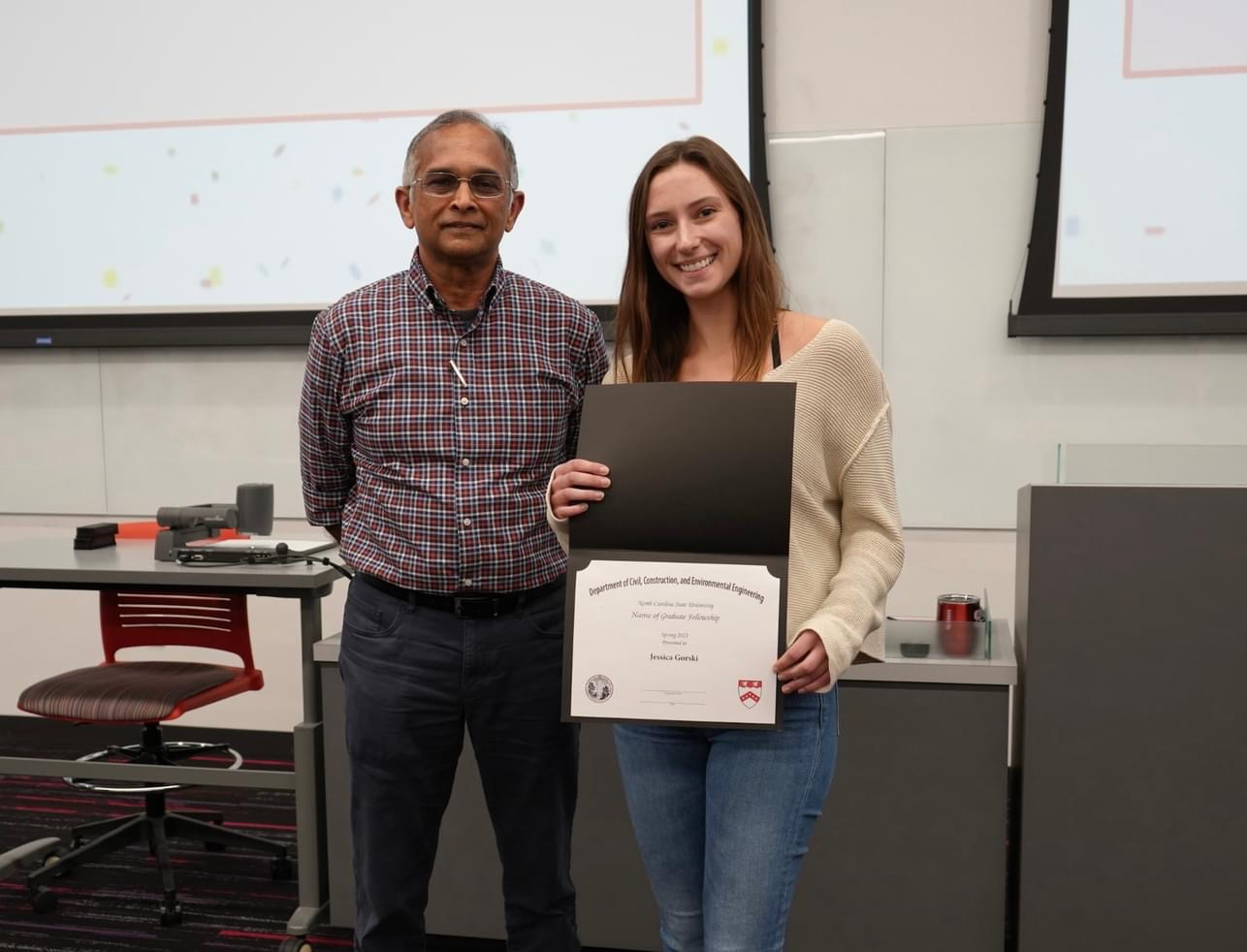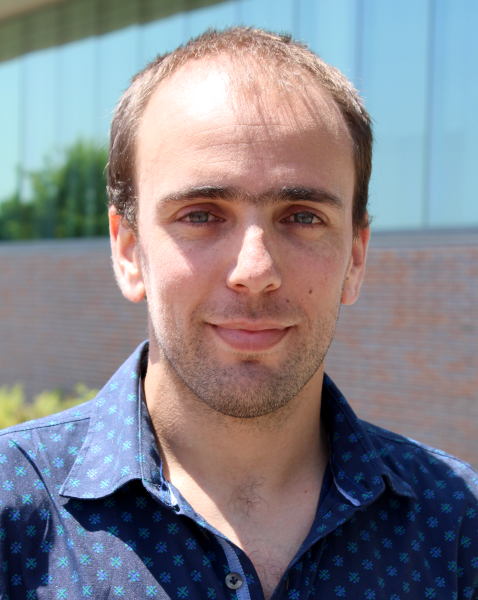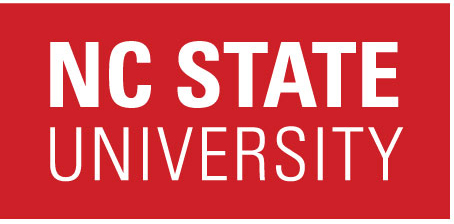Congratulations to Jessica!

Jessica Gorski (right) celebrates her award, with Ranji Ranjithan.

Congratulations to Jessica!

Jessica Gorski (right) celebrates her award, with Ranji Ranjithan.
![]()
University of Delaware civil engineers are leading a multi-institutional effort to identify the best models to calculate flood risk at coastal military installations where climate change threatens to increase the risk of flood damage from sea level rise and storm surge.
The four-year project, which launched in mid-2022 and will run through spring 2025, is funded by a $2.2 million grant from the U.S. Department of Defense (DoD). Project partners include faculty and students from the Netherlands, North Carolina State University, the University of South Alabama, Texas A&M and the United States Geological Survey (USGS).
…
“The goal is to provide guidance to the DoD about the strengths and weaknesses of each model in comparison. They’re all going to have things they’re good with and things they struggle with,” Dietrich said. Those comparisons will help the agencies decide what types of models they want to use to get what types of information — depending on how much time, effort and funding they want to commit.
There’s also a goal of reducing cost and building smarter models, he said.
“If we are able to improve our predictions at very specific sites along the coast, we also can have better predictions at other specific sites along the coast, like someone’s house or a bridge or other infrastructure,” Dietrich said.
 Dunes and beaches are vulnerable to erosion during storm events. Numerical models can predict beach response to storms with fidelity, but their computational costs, the domain-specific knowledge necessary to use them, and the wide range of potential future storm and beach conditions can hinder their use in forecasting storm erosion for short- and long-term horizons. We develop an emulator, which is an efficient predictive model that behaves like a numerical model, to predict the morphologic response of the subaerial beach to storms. Specific emphasis is placed on providing antecedent beach states as an input to the emulator and predicting the post-storm profile shape. Training data include beach profiles at multiple stages in a nourishment life cycle to assess if such a framework can be applied in locations that nourish as a coastal defense policy. Development and application of the emulator is focused on Nags Head, North Carolina, which nourishes its beaches to mitigate hazards of storm waves, flooding, and erosion. A high-fidelity, process-based morphodynamic model is used to train the emulator with 1250 scenarios of sea-storms and beach profiles. The post-storm beach state is emulated with a parameterized power-law function fit to the eroded portion of the subaerial profile. When the emulator was tested for a sequence of real storms from 2019, the eroded beach profiles were predicted with a skill score of 0.66. This emulator is promising for future efforts to predict storm-induced beach erosion in hazard warnings or adaptation studies.
Dunes and beaches are vulnerable to erosion during storm events. Numerical models can predict beach response to storms with fidelity, but their computational costs, the domain-specific knowledge necessary to use them, and the wide range of potential future storm and beach conditions can hinder their use in forecasting storm erosion for short- and long-term horizons. We develop an emulator, which is an efficient predictive model that behaves like a numerical model, to predict the morphologic response of the subaerial beach to storms. Specific emphasis is placed on providing antecedent beach states as an input to the emulator and predicting the post-storm profile shape. Training data include beach profiles at multiple stages in a nourishment life cycle to assess if such a framework can be applied in locations that nourish as a coastal defense policy. Development and application of the emulator is focused on Nags Head, North Carolina, which nourishes its beaches to mitigate hazards of storm waves, flooding, and erosion. A high-fidelity, process-based morphodynamic model is used to train the emulator with 1250 scenarios of sea-storms and beach profiles. The post-storm beach state is emulated with a parameterized power-law function fit to the eroded portion of the subaerial profile. When the emulator was tested for a sequence of real storms from 2019, the eroded beach profiles were predicted with a skill score of 0.66. This emulator is promising for future efforts to predict storm-induced beach erosion in hazard warnings or adaptation studies.
 M.S. student Tomás Cuevas López was awarded a fellowship from the Chilean National Research and Development Agency. The Beca de Magister en el Extranjero supports Chilean students pursuing master’s degrees abroad. Awarded students are requested to eventually return to Chile to apply the new knowledge to contribute to the scientific, academic, economic, social, and cultural development of the country. Out of the 605 students that applied for the fellowship, 128 were selected. Tomás is one of only two Chilean students studying in the U.S. to receive the fellowship during this cycle.
M.S. student Tomás Cuevas López was awarded a fellowship from the Chilean National Research and Development Agency. The Beca de Magister en el Extranjero supports Chilean students pursuing master’s degrees abroad. Awarded students are requested to eventually return to Chile to apply the new knowledge to contribute to the scientific, academic, economic, social, and cultural development of the country. Out of the 605 students that applied for the fellowship, 128 were selected. Tomás is one of only two Chilean students studying in the U.S. to receive the fellowship during this cycle.
Read more about the award on our department web site.
Congratulations to Tomás!
 Ph.D. student Jenero Knowles was awarded the Witherspoon Graduate Fellowship from NC State’s Graduate School. The competitive one-year award is given to rising second-year graduate students who support Black communities at NC State and beyond, and selections were made by representatives from the Black Alumni Society and Graduate School. The award is named in honor of Dr. Augustus M. Witherspoon, who was the second Black graduate student to receive a doctorate from NC State and the first Black professor at the university.
Ph.D. student Jenero Knowles was awarded the Witherspoon Graduate Fellowship from NC State’s Graduate School. The competitive one-year award is given to rising second-year graduate students who support Black communities at NC State and beyond, and selections were made by representatives from the Black Alumni Society and Graduate School. The award is named in honor of Dr. Augustus M. Witherspoon, who was the second Black graduate student to receive a doctorate from NC State and the first Black professor at the university.
Read more about the award on our department web site.
Congratulations to Jenero!
Alireza is now a coastal engineer with Taylor Engineering, Inc., and Carter will start his MS studies at Oregon State University. We also celebrated the graduation of Vega Sproul, who was an intern at the Coastal Studies Institute and then an undergraduate researcher with Dr. Beth Sciaudone. We are extremely proud of them!

From left to right: Alireza Gharagozlou, Casey Dietrich, Carter Howe, and Vega Sproul celebrate graduation.
 Carter Howe was featured on social media in a teaser video for our department’s graduation ceremony. He gives advice to get involved in clubs and build connections with students and friends. We are proud of Carter!
Carter Howe was featured on social media in a teaser video for our department’s graduation ceremony. He gives advice to get involved in clubs and build connections with students and friends. We are proud of Carter!